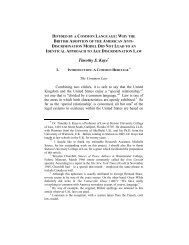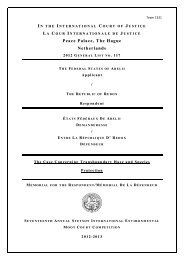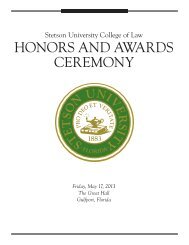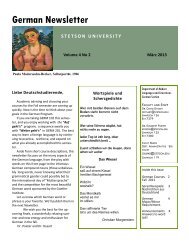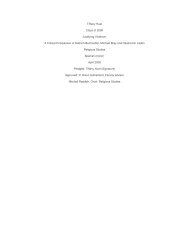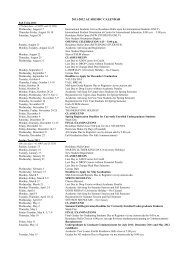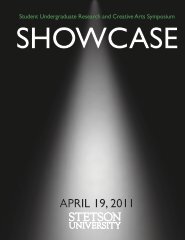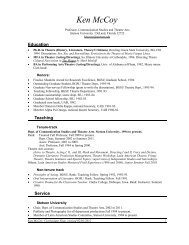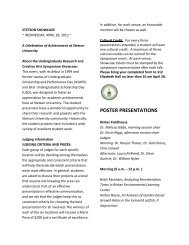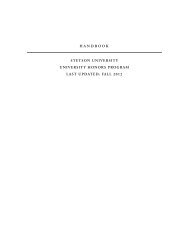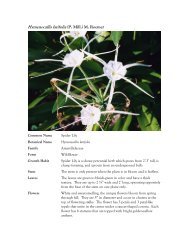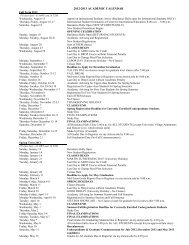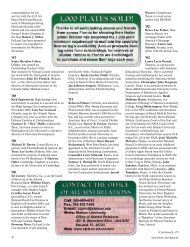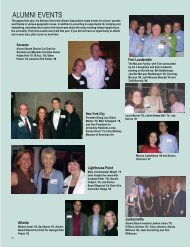If you can dream it, you can do it - Stetson University
If you can dream it, you can do it - Stetson University
If you can dream it, you can do it - Stetson University
Create successful ePaper yourself
Turn your PDF publications into a flip-book with our unique Google optimized e-Paper software.
Individuals <strong>can</strong> make a difference<br />
AIR's Projects<br />
By Molly Justice and Mary Napier<br />
One <strong>Stetson</strong> Univers<strong>it</strong>y student who took Dr. Anne Hallum's<br />
environmental pol<strong>it</strong>ics lessons to heart was 21-year-old<br />
Brooke Lacy of Edgewater.<br />
Lacy, now a pol<strong>it</strong>ical science senior, was one of two<br />
students who traveled to Nicaragua for five weeks in the<br />
Reforestation nurseries<br />
Thirty-five commun<strong>it</strong>y-run nurseries annually<br />
produce more than 200,000 trees. As each permanent<br />
nursery becomes self-sufficient, Alliance for<br />
International Reforestation Inc. moves on to another<br />
commun<strong>it</strong>y.<br />
summer of 2000 to participate in the Alliance for International Reforestation<br />
Agroforestry systems<br />
(AIR) Inc. program. Students are able to participate in the program thanks to AIR has trained more than 300 farmers to incorpo-<br />
all-expense-paid internships funded by <strong>Stetson</strong> Trustee David Rinker.<br />
rate trees into agricultural fields. They're also<br />
"I was impressed w<strong>it</strong>h the things they did and that <strong>it</strong> was commun<strong>it</strong>y-<br />
training them in non-chemical farming practices that<br />
based," Lacy said of the program.<br />
The students divided their time between planting trees; working in the<br />
are safer and cheaper.<br />
three established nurseries in Rio Abajo, Casa Blanca and El Mango; and<br />
Fuel-efficient stoves<br />
providing education about the environment to children of all ages.<br />
Since 1995, AIR and the commun<strong>it</strong>y members and<br />
"We kept our programs w<strong>it</strong>h the children fun and interactive, even<br />
vis<strong>it</strong>ing work teams have built more than 500 brick<br />
providing compet<strong>it</strong>ions complete w<strong>it</strong>h prizes, such as <strong>do</strong>nated stuffed animals<br />
and bubbles," she said. "Because the nurseries had been previously established<br />
stoves, saving 500 tons of wood a year.<br />
in their villages, the children were already aware of AIR, which made our<br />
Environmental education<br />
work easier."<br />
AIR provides textbooks and educates more than 120<br />
Lacy said the most surprising thing she learned during the experience was rural teachers annually to implement a reforestation<br />
the Nicaraguan people's desire for their country to be more like the Un<strong>it</strong>ed curriculum in their classrooms. More than 4,000<br />
States.<br />
students learn the basics of ecology<br />
"They all wanted to come here,"<br />
she said.<br />
and participate in planting trees.<br />
However, Lacy said she tried to<br />
Radio<br />
convey to the people that they possess<br />
Another key part of environmental<br />
many non-material gifts that most<br />
education has been the weekly<br />
Ameri<strong>can</strong>s lack.<br />
radio program produced by and<br />
"I went w<strong>it</strong>h the intention of<br />
featuring AIR staff. The show<br />
figuring out what I could <strong>do</strong> to make<br />
includes practical information on<br />
Nicaragua more like the Un<strong>it</strong>ed<br />
soil conservation, organic fertilizers,<br />
States, but I left trying to figure out<br />
how I could make the Un<strong>it</strong>ed States<br />
fru<strong>it</strong> tree grafting and much more.<br />
operate more like Nicaragua from a<br />
Medicinal plants<br />
human perspective," she said. "They<br />
Since 1997, AIR has worked in the<br />
were just so humble, so caring and<br />
production and packaging of<br />
sharing. They never lost sight about<br />
what life is really about."<br />
The lessons Lacy learned in<br />
Nicaragua were exactly what Hallum<br />
is trying to teach her students.<br />
"I want students to see how<br />
Brooke Lacy, back left, and Ashleigh<br />
Miller, back right, are surrounded by<br />
bubble-blowing Nicaraguan children<br />
during their summer 2000 internship<br />
w<strong>it</strong>h AIR in Esteli, Nicaragua.<br />
medicinal plants in six commun<strong>it</strong>ies.<br />
The indigenous local Mayan<br />
women have been instrumental in<br />
sharing their wis<strong>do</strong>m about these<br />
gardens.<br />
individuals <strong>can</strong> make a difference," Hallum said. "They will begin to see<br />
<strong>Stetson</strong> Univers<strong>it</strong>y internships<br />
the real<strong>it</strong>y of how two-thirds of the world lives and know that the Un<strong>it</strong>ed A new grant creates summer internships for <strong>Stetson</strong><br />
States is part of the exception. I want them to be cr<strong>it</strong>ical of our weaknesses, Univers<strong>it</strong>y students to work in Guatemala or<br />
which <strong>can</strong> be brought on by overabundance. Sometimes students start to<br />
realize that the most important values are not those of materialism."<br />
Lacy, a Pelham Scholar at <strong>Stetson</strong>, is involved in church activ<strong>it</strong>ies and<br />
played professional women's tackle football w<strong>it</strong>h the Daytona Beach<br />
Barracudas last fall/winter. She plans someday to pursue a career in pol<strong>it</strong>ics.<br />
Nicaragua w<strong>it</strong>h AIR staff.<br />
14 STETSON UNIVERSITY



